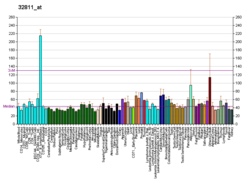Myosin-Ic is a protein that in humans is encoded by the MYO1C gene.
This gene encodes a member of the unconventional myosin protein family, which are actin-based molecular motors. The protein is found in the cytoplasm, and one isoform with a unique N-terminus is also found in the nucleus. The nuclear isoform associates with RNA polymerase I and II and functions in transcription initiation. The mouse ortholog of this protein also functions in intracellular vesicle transport to the plasma membrane. Multiple transcript variants encoding different isoforms have been found for this gene. The related gene myosin IE has been referred to as myosin IC in the literature, but it is a distinct locus on chromosome 19.
References
- ^ GRCh38: Ensembl release 89: ENSG00000197879 – Ensembl, May 2017
- ^ GRCm38: Ensembl release 89: ENSMUSG00000017774 – Ensembl, May 2017
- "Human PubMed Reference:". National Center for Biotechnology Information, U.S. National Library of Medicine.
- "Mouse PubMed Reference:". National Center for Biotechnology Information, U.S. National Library of Medicine.
- Crozet F, el Amraoui A, Blanchard S, Lenoir M, Ripoll C, Vago P, Hamel C, Fizames C, Levi-Acobas F, Depetris D, Mattei MG, Weil D, Pujol R, Petit C (Apr 1997). "Cloning of the genes encoding two murine and human cochlear unconventional type I myosins". Genomics. 40 (2): 332–41. doi:10.1006/geno.1996.4526. PMID 9119401.
- ^ "Entrez Gene: MYO1C myosin IC".
Further reading
- Ruppert C, Godel J, Müller RT, et al. (1997). "Localization of the rat myosin I molecules myr 1 and myr 2 and in vivo targeting of their tail domains". J. Cell Sci. 108 (12): 3775–86. doi:10.1242/jcs.108.12.3775. PMID 8719884.
- Hasson T, Skowron JF, Gilbert DJ, et al. (1997). "Mapping of unconventional myosins in mouse and human". Genomics. 36 (3): 431–9. doi:10.1006/geno.1996.0488. PMID 8884266.
- Skowron JF, Bement WM, Mooseker MS (1999). "Human brush border myosin-I and myosin-Ic expression in human intestine and Caco-2BBe cells". Cell Motil. Cytoskeleton. 41 (4): 308–24. doi:10.1002/(SICI)1097-0169(1998)41:4<308::AID-CM4>3.0.CO;2-J. PMID 9858156.
- Pestic-Dragovich L, Stojiljkovic L, Philimonenko AA, et al. (2000). "A myosin I isoform in the nucleus". Science. 290 (5490): 337–41. Bibcode:2000Sci...290..337P. doi:10.1126/science.290.5490.337. PMID 11030652.
- Strausberg RL, Feingold EA, Grouse LH, et al. (2003). "Generation and initial analysis of more than 15,000 full-length human and mouse cDNA sequences". Proc. Natl. Acad. Sci. U.S.A. 99 (26): 16899–903. Bibcode:2002PNAS...9916899M. doi:10.1073/pnas.242603899. PMC 139241. PMID 12477932.
- Brandenberger R, Wei H, Zhang S, et al. (2005). "Transcriptome characterization elucidates signaling networks that control human ES cell growth and differentiation". Nat. Biotechnol. 22 (6): 707–16. doi:10.1038/nbt971. PMID 15146197. S2CID 27764390.
- Beausoleil SA, Jedrychowski M, Schwartz D, et al. (2004). "Large-scale characterization of HeLa cell nuclear phosphoproteins". Proc. Natl. Acad. Sci. U.S.A. 101 (33): 12130–5. Bibcode:2004PNAS..10112130B. doi:10.1073/pnas.0404720101. PMC 514446. PMID 15302935.
- Suzuki Y, Yamashita R, Shirota M, et al. (2004). "Sequence comparison of human and mouse genes reveals a homologous block structure in the promoter regions". Genome Res. 14 (9): 1711–8. doi:10.1101/gr.2435604. PMC 515316. PMID 15342556.
- Philimonenko VV, Zhao J, Iben S, et al. (2005). "Nuclear actin and myosin I are required for RNA polymerase I transcription". Nat. Cell Biol. 6 (12): 1165–72. doi:10.1038/ncb1190. PMID 15558034. S2CID 6633625.
- Kyselá K, Philimonenko AA, Philimonenko VV, et al. (2005). "Nuclear distribution of actin and myosin I depends on transcriptional activity of the cell". Histochem. Cell Biol. 124 (5): 347–58. doi:10.1007/s00418-005-0042-8. PMID 16133118. S2CID 28731167.
- Kimura K, Wakamatsu A, Suzuki Y, et al. (2006). "Diversification of transcriptional modulation: large-scale identification and characterization of putative alternative promoters of human genes". Genome Res. 16 (1): 55–65. doi:10.1101/gr.4039406. PMC 1356129. PMID 16344560.
- Cavellán E, Asp P, Percipalle P, Farrants AK (2006). "The WSTF-SNF2h chromatin remodeling complex interacts with several nuclear proteins in transcription". J. Biol. Chem. 281 (24): 16264–71. doi:10.1074/jbc.M600233200. PMID 16603771.
- Cisterna B, Necchi D, Prosperi E, Biggiogera M (2006). "Small ribosomal subunits associate with nuclear myosin and actin in transit to the nuclear pores". FASEB J. 20 (11): 1901–3. doi:10.1096/fj.05-5278fje. PMID 16877530. S2CID 24892289.
- Kahle M, Pridalová J, Spacek M, et al. (2007). "Nuclear myosin is ubiquitously expressed and evolutionary conserved in vertebrates". Histochem. Cell Biol. 127 (2): 139–48. doi:10.1007/s00418-006-0231-0. PMID 16957816. S2CID 23325557.
- Hofmann WA, Vargas GM, Ramchandran R, et al. (2006). "Nuclear myosin I is necessary for the formation of the first phosphodiester bond during transcription initiation by RNA polymerase II". J. Cell. Biochem. 99 (4): 1001–9. doi:10.1002/jcb.21035. PMID 16960872. S2CID 39237955.
- Olsen JV, Blagoev B, Gnad F, et al. (2006). "Global, in vivo, and site-specific phosphorylation dynamics in signaling networks". Cell. 127 (3): 635–48. doi:10.1016/j.cell.2006.09.026. PMID 17081983. S2CID 7827573.
- Ewing RM, Chu P, Elisma F, et al. (2007). "Large-scale mapping of human protein-protein interactions by mass spectrometry". Mol. Syst. Biol. 3 (1): 89. doi:10.1038/msb4100134. PMC 1847948. PMID 17353931.
External links
- Overview of all the structural information available in the PDB for UniProt: O00159 (Unconventional myosin-Ic) at the PDBe-KB.
| Proteins of the cytoskeleton | |||||||||||||||||||||||||||||||||||||||||||||||||||||
|---|---|---|---|---|---|---|---|---|---|---|---|---|---|---|---|---|---|---|---|---|---|---|---|---|---|---|---|---|---|---|---|---|---|---|---|---|---|---|---|---|---|---|---|---|---|---|---|---|---|---|---|---|---|
| Human |
| ||||||||||||||||||||||||||||||||||||||||||||||||||||
| Nonhuman | |||||||||||||||||||||||||||||||||||||||||||||||||||||
| See also: cytoskeletal defects | |||||||||||||||||||||||||||||||||||||||||||||||||||||
This article on a gene on human chromosome 17 is a stub. You can help Misplaced Pages by expanding it. |





